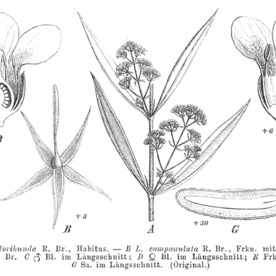Herbs, undershrubs or shrubs. Leaves opposite, entire, sometimes greatly reduced, petiolate or sessile; stipules interpetiolar, membranous. Inflorescence terminal, often appearing axillary when developing from short lateral shoots, variously cymose, often much-branched, 1–many-flowered. Flowers usually small, bisexual or unisexual and then plants dioecious, usually 5-merous. Calyx lobes obtuse to acute to tapering, ciliate. Corolla white to yellow, campanulate or with tube cylindrical; lobes imbricate in bud, rounded at apex or nearly so, ±entire, spreading. Stamens inserted about halfway up corolla tube or in throat, included to just exserted; anthers orbicular to narrowly oblong. Ovary superior, ovoid or nearly so, with several ovules in each locule; style thick, included or exserted; stigma large, subglobose (capitate) or oblong, undivided or bilobed. Fruit a septicidal capsule, subglobose or ellipsoidal, with two carpels almost completely separating from apex to base, apiculate at apex (style sometimes persisting); valves coriaceous, dehiscing only in distal half, usually black, woody. Seeds ±ellipsoidal, brown.
More
Fls regular, perfect or unisexual, terminal or axillary, solitary or in few-fld cymes. Calyx-5-lobed; corolla 5-(4)-lobed; stamens 5-(4), on corolla-tube, filaments filiform. Ovary 2-loculed; style 1; stigma ± capitate; ovules several per locule. Capsule ± globose, 2-valved, septicidally dehiscent; placentae axile. Small shrubs or herb with opp., entire lvs; stipules us. reduced to a transverse line. Some 25 Australian spp., the N. Z. sp. endemic.

